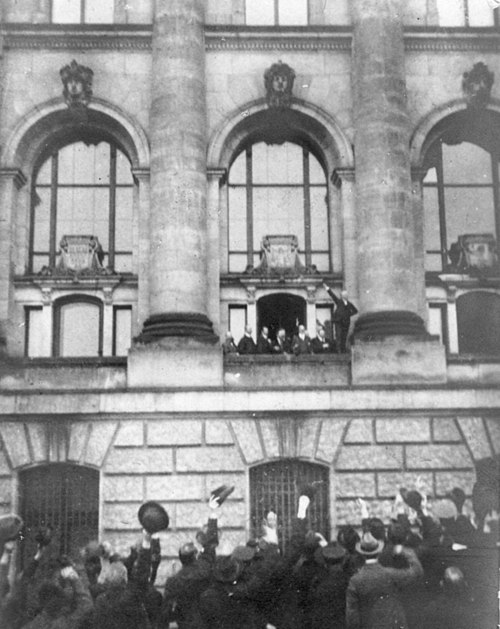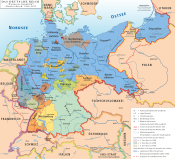Weimar Republic
- Afrikaans
- Alemannisch
- العربية
- Aragonés
- Asturianu
- Azərbaycanca
- تۆرکجه
- বাংলা
- Башҡортса
- Беларуская
- Беларуская (тарашкевіца)
- Български
- Bosanski
- Brezhoneg
- Буряад
- Català
- Чӑвашла
- Čeština
- Cymraeg
- Dansk
- Deutsch
- Dolnoserbski
- Eesti
- Ελληνικά
- Español
- Esperanto
- Euskara
- فارسی
- Français
- Frysk
- Gaeilge
- Gaelg
- Gàidhlig
- Galego
- 한국어
- Հայերեն
- हिन्दी
- Hornjoserbsce
- Hrvatski
- Ido
- Bahasa Indonesia
- Interlingua
- Íslenska
- Italiano
- עברית
- ქართული
- Қазақша
- Kiswahili
- Kurdî
- Кыргызча
- Latina
- Latviešu
- Lëtzebuergesch
- Lietuvių
- Limburgs
- Magyar
- Македонски
- Malagasy
- മലയാളം
- मराठी
- მარგალური
- مصرى
- Bahasa Melayu
- Монгол
- Nederlands
- 日本語
- Nordfriisk
- Norsk bokmål
- Norsk nynorsk
- Oʻzbekcha / ўзбекча
- پنجابی
- Papiamentu
- پښتو
- ភាសាខ្មែរ
- Piemontèis
- Polski
- Português
- Română
- Русский
- Sardu
- Scots
- Shqip
- Simple English
- Slovenčina
- Slovenščina
- کوردی
- Српски / srpski
- Srpskohrvatski / српскохрватски
- Suomi
- Svenska
- Tagalog
- Татарча / tatarça
- ไทย
- Türkçe
- Українська
- اردو
- Tiếng Việt
- Winaray
- 吴语
- ייִדיש
- Yorùbá
- 粵語
- 中文
German Reich Deutsches Reich (German) | |||||||||
|---|---|---|---|---|---|---|---|---|---|
| 1918–1933[1][2][3] | |||||||||
Flag
(1919–1933) | |||||||||
| Motto: | |||||||||
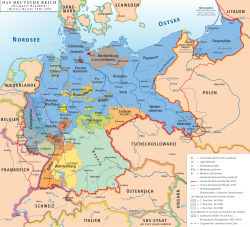 German States in 1925 (with Prussia and its provinces shown in blue) German States in 1925 (with Prussia and its provinces shown in blue) | |||||||||
| Capital and largest city | Berlin 52°31′N 13°23′E / 52.517°N 13.383°E / 52.517; 13.383 | ||||||||
| Official languages | German | ||||||||
| Common languages | Unofficial: | ||||||||
| Religion | 1925 census:[5] | ||||||||
semi-presidential republic (1919–1930) Federal authoritarian presidential republic under a parliamentary system (1930–1933) | |||||||||
| President | |||||||||
• 1919–1925 | Friedrich Ebert | ||||||||
• 1925–1933 | Paul von Hindenburg | ||||||||
| Chancellor | |||||||||
• 1919 (first) | Friedrich Ebert | ||||||||
• 1933 (last) | Adolf Hitler | ||||||||
| Legislature | Bicameral | ||||||||
| Reichsrat (de facto) | |||||||||
| Reichstag | |||||||||
| Historical era | Interwar period | ||||||||
• Established | 9 November 1918 | ||||||||
| 11 August 1919 | |||||||||
• Admitted to the League of Nations | 8 September 1926 | ||||||||
• Rule by decree begins | 29 March 1930[6] | ||||||||
• Hitler inaugurated Chancellor | 30 January 1933 | ||||||||
| 27 February 1933 | |||||||||
| 23 March 1933[1][2][3] | |||||||||
| Area | |||||||||
| 1925[7] | 468,787 km2 (181,000 sq mi) | ||||||||
| Population | |||||||||
• 1925[7] | 62,411,000 | ||||||||
• Density | 133.129/km2 (344.8/sq mi) | ||||||||
| Currency |
| ||||||||
| |||||||||
| Today part of | |||||||||
Part of a series on the |
||||||||||
|---|---|---|---|---|---|---|---|---|---|---|
| History of Germany | ||||||||||
 | ||||||||||
|
Topics
|
||||||||||
|
Early history |
||||||||||
|
||||||||||
|
||||||||||
The Weimar Republic,
After the end of the
In its initial years, grave problems beset the Republic, such as hyperinflation and political extremism, including political murders and two attempted seizures of power by contending paramilitaries; internationally, it suffered isolation, reduced diplomatic standing and contentious relationships with the great powers. By 1924, a great deal of monetary and political stability was restored, and the republic enjoyed relative prosperity for the next five years; this period, sometimes known as the Golden Twenties, was characterised by significant cultural flourishing, social progress, and gradual improvement in foreign relations. Under the Locarno Treaties of 1925, Germany moved toward normalising relations with its neighbours, recognising most territorial changes under the 1919 Treaty of Versailles and committing never to go to war. The following year, it joined the League of Nations, which marked its reintegration into the international community.[e][9] Nevertheless, especially on the political right, there remained strong and widespread resentment against the treaty and those who had signed and supported it.
The Great Depression of October 1929 severely impacted Germany's tenuous progress; high unemployment and subsequent social and political unrest led to the collapse of Chancellor Hermann Müller's grand coalition and the beginning of the presidential cabinets. From March 1930 onwards, President Paul von Hindenburg used emergency powers to back Chancellors Heinrich Brüning, Franz von Papen and General Kurt von Schleicher. The Great Depression, exacerbated by Brüning's policy of deflation, led to a surge in unemployment.[10] On 30 January 1933, Hindenburg appointed Adolf Hitler as Chancellor to head a coalition government; Hitler's far-right Nazi Party held two out of ten cabinet seats. Von Papen, as Vice-Chancellor and Hindenburg's confidant, was to serve as the éminence grise who would keep Hitler under control; these intentions severely underestimated Hitler's political abilities. By the end of March 1933, the Reichstag Fire Decree and the Enabling Act of 1933 were used in the perceived state of emergency to effectively grant the new Chancellor broad power to act outside parliamentary control. Hitler promptly used these powers to thwart constitutional governance and suspend civil liberties, which brought about the swift collapse of democracy at the federal and state level, and the creation of a one-party dictatorship under his leadership.
Until the
Name and symbols
The Weimar Republic is so called because the Weimar National Assembly that adopted its constitution met in Weimar from 6 February to 11 August 1919,[11] but the name only became mainstream after 1933.
Terminology
Even though the National Assembly chose to retain the old name Deutsches Reich (Art. 1 of the Constitution),[12] hardly anyone used it during the Weimar period, and no single name for the new state gained widespread acceptance.[13] To the right of the spectrum, the politically engaged rejected the new democratic model and were appalled to see the honour of the traditional word Reich associated with it.[14] The Catholic Centre Party favoured the term Deutscher Volksstaat (German People's State),[f] while on the moderate left, Chancellor Friedrich Ebert's Social Democratic Party of Germany preferred Deutsche Republik (German Republic).[14] By the mid-1920s, most Germans referred to their government informally as the Deutsche Republik, but for many, especially on the right, the word "Republik" was a painful reminder of a government structure that they believed had been imposed by foreign statesmen and of the expulsion of Emperor Wilhelm II in the wake of a massive national humiliation.[14]
The first recorded mention of the term Republik von Weimar (Republic of Weimar) came during a speech delivered by Adolf Hitler at a Nazi Party rally in Munich on 24 February 1929. A few weeks later, the term Weimarer Republik was first used again by Hitler in a newspaper article.[13] Only during the 1930s did the term become mainstream, both within and outside Germany.
According to historian Richard J. Evans:[15]
The continued use of the term 'German Empire', Deutsches Reich, by the Weimar Republic ... conjured up an image among educated Germans that resonated far beyond the institutional structures Bismarck created: the successor to the Roman Empire; the vision of God's Empire here on earth; the universality of its claim to suzerainty; and a more prosaic but no less powerful sense, the concept of a German state that would include all German speakers in central Europe—'one People, one Reich, one Leader', as the Nazi slogan was to put it.
Flag and coat of arms
The black-red-gold tricolour of the
Armed forces
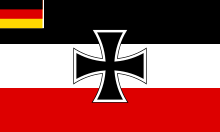
The official formation of the Reichswehr took place on 1 January 1921, after the limitations had been met. The soldiers of the Reichswehr took their oath to the
During the 1920 Kapp Putsch, Seeckt refused to deploy the Reichswehr against the Freikorps involved in the putsch[20] but immediately afterwards had the Ruhr Red Army brutally suppressed during the Ruhr uprising. In 1921 the Reichswehr organized the Black Reichswehr, a secret reserve networked within the Reichswehr and organised as labour battalions (Arbeitskommandos) to circumvent the Treaty of Versailles' 100,000 man limit on the German army.[21] The Black Reichswehr was never involved in direct military action and was dissolved in 1923 after a group of its members attempted to overthrow the government in the Küstrin Putsch.[22] The Reichswehr also developed far-reaching cooperation with the Soviet Red Army, leading among other things to the secret training of German military pilots in clear violation of the Treaty of Versailles.[23]
With Seeckt's fall in 1926, the Reichswehr made a change in course for which Colonel Kurt von Schleicher was primarily responsible. The goal was to arouse broad social support for rearmament and to militarize society itself for the purpose of future warfare.[24] Under Paul von Hindenburg's Reich presidency, Reichswehr leadership gained increasing political influence and eventually helped determine the composition of the Reich governments. As a result, the Reichswehr contributed significantly to the development of an authoritarian presidential system during the final phase of the Weimar Republic.[25]
In 1935, two years after Adolf Hitler's rise to power, the Reichswehr was renamed Wehrmacht. It was the unified armed forces of the Nazi regime.
History
Background
Germany and the Central Powers fought the Allies of WWI between 28 July 1914 and 11 November 1918. The war ended with 20 million military and civilian deaths,[26] including 2,037,000 German soldiers[27] and from 424,000[28] to 763,000[29][30] civilians, many of them from disease and starvation as a result of the Allied blockade of Germany.
After four years of war on multiple fronts in Europe and around the world, the final
Germany lost the war because its allies were facing defeat and its economic resources were running out, while by late summer 1918 fresh American troops were arriving in France at the rate of 10,000 per day. Support among the population had begun to crumble in 1916, and by mid-1918 many Germans wanted an end to the war. Increasing numbers of them began to associate with the political left, such as the
November Revolution (1918–1919)
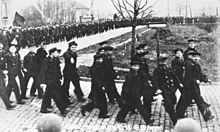
On 29 October 1918, a rebellion broke out among sailors at Wilhelmshaven; similar unrest then spread to become the Kiel mutiny on 3 November. Sailors, soldiers and workers began electing workers' and soldiers' councils (Arbeiter- und Soldatenräte) modelled after the soviets of the 1917 Russian Revolution. The revolution spread throughout Germany, and participants seized military and civil power in individual cities.[40] The power takeovers were achieved everywhere without loss of life.[citation needed]
At the time, the socialist movement, which represented mostly labourers, was split among two major left-wing parties: the Independent Social Democratic Party of Germany (USPD), which called for immediate peace negotiations and favoured a soviet-style command economy, and the Social Democratic Party of Germany (SPD), also known as the Majority Social Democratic Party of Germany (MSPD), which had supported the war and favoured a parliamentary system. The rebellion caused great fear among supporters of the monarchy and in the middle classes because of the soviet-style aspirations of the councils. To centrist and conservative citizens, the country looked to be on the verge of a communist revolution.[41]
By 7 November the revolution had reached
On 9 November 1918, the German Republic was proclaimed by MSPD member Philipp Scheidemann at the Reichstag building in Berlin, angering Friedrich Ebert, the leader of the MSPD, who thought that the question of monarchy or republic should be answered by a national assembly.[45] Two hours later, a Free Socialist Republic was proclaimed at the Berlin Palace. The proclamation was issued by Karl Liebknecht, co-leader with Rosa Luxemburg of the communist Spartakusbund (Spartacus League), a group of a few hundred supporters of the Russian Revolution that had allied itself with the USPD in 1917.[46] On the same day, in a move that was contrary to the constitution because only the Kaiser could appoint a chancellor, Prince Max of Baden, at Ebert's request, transferred his powers as chancellor to him.[47] In view of the mass support for more radical reforms among the workers' councils, a coalition government called the Council of the People's Deputies (Rat der Volksbeauftragten) was established, consisting of three MSPD and three USPD members. Led by Ebert for the MSPD and Hugo Haase for the USPD, it governed Germany from November 1918 to January 1919.[48] Although the new government was confirmed by the Berlin Workers' and Soldiers' Council, it was opposed by the Spartacus League.
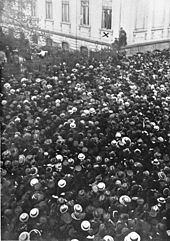
On 11 November 1918, an armistice was signed at Compiègne by German representatives. It effectively ended military operations between the Allies and Germany. It amounted to a German capitulation, without any concessions by the Allies; the naval blockade was to continue until complete peace terms were agreed on.[49]
The Executive Council of the Workers' and Soldiers' Council of Greater Berlin called for a National Congress of Councils (Reichsrätekongress) which took place from 16 to 21 December 1918. Against the opposition of the more radical members who demanded a socialist republic, Ebert, backed by the large MSPD majority at the Congress, was able to schedule elections for a provisional National Assembly that would act as an interim parliament and be given the task of writing a democratic constitution for a parliamentary government.[50]
To ensure that the fledgling government maintained control over the country, Ebert and General Wilhelm Groener, Ludendorff's successor as leader of the Supreme Army Command (OHL), concluded the secret Ebert–Groener pact on 10 November. Over the telephone, Ebert promised that he would allow sole command of the troops to remain with the officer corps, while Groener pledged that the military would be loyal to the government and that it would help it in its fight against left-wing revolutionaries.[51] The agreement marked the acceptance of the new government by the military, but the new Reichswehr armed forces, limited by the Treaty of Versailles to 100,000 army soldiers and 15,000 sailors, remained fully under the control of the German officer class.[52]
A rift developed between the MSPD and USPD after Ebert called upon the OHL for troops to put down a mutiny by a leftist military unit on 23/24 December 1918 in which members of the Volksmarinedivision (People's Navy Division) captured the city's garrison commander Otto Wels of the MSPD and occupied the Reich Chancellery where the Council of the People's Deputies had its offices. The ensuing street fighting left 11 Volksmarinedivision members and 56 members of the regular army dead.[53] The USPD leaders were angered by what they believed was treachery by the MSPD, which in their view had joined with the anti-communist military to suppress the revolution. As a result, the USPD left the Council of the People's Deputies after only seven weeks. On 30 December, the split deepened when the Communist Party of Germany (KPD) was formed out of a number of radical left-wing groups, including the Spartacus League and the left wing of the USPD.[46]
In January, the Spartacus League, in what was known as the Spartacist uprising, took advantage of a large strike in Berlin and attempted to establish a communist government. The uprising was put down by paramilitary Freikorps units consisting of volunteer soldiers. Following bloody street fights, Rosa Luxemburg and Karl Liebknecht were summarily killed after their arrests on 15 January.[54] With the affirmation of Ebert, those responsible were not tried before a court-martial, leading to lenient sentences, which made Ebert unpopular among radical leftists.[citation needed]
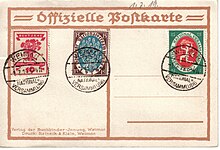
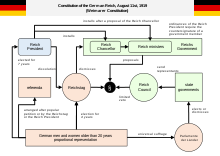
The National Assembly elections, in which women were allowed to vote for the first time, took place on 19 January 1919.[55] The MSPD won the largest share of the votes at 37.9%, with the USPD fifth at 7.6%.[56] To avoid the ongoing fights in Berlin, the National Assembly convened in the city of Weimar, giving the future Republic its unofficial name. The Weimar Constitution created a parliamentary republic with the Reichstag elected by proportional representation.[57]
During the debates in Weimar, fighting continued sporadically across Germany. On 7 April 1919 the
Years of crisis (1919–1923)
Burden from the First World War
In the four years following the First World War, the situation of most German civilians remained dire. The post-war economic crisis was a result of lost pre-war industrial exports, the loss of imported raw materials and foodstuffs due to the continental blockade, the loss of Germany's overseas colonies and the worsening debt balances that had been exacerbated by Germany's heavy reliance on bonds to pay for the war. The economic losses can be attributed in part to the extension of the Allied blockade of Germany until the Treaty of Versailles was signed on 28 June 1919. It is estimated that between 100,000[60] and 250,000[61]: 166 German civilians died of disease or starvation between the end of the war and the signing of the treaty. Many German civilians expected life to return to pre-war normality after it was lifted, but the severe food shortages continued. In 1922, for example, meat consumption had not increased since the war years. At 22 kilograms per person per year, it was less than half of the 52 kilograms consumed in 1913. German citizens felt the food shortages more deeply than during the war because the reality contrasted so starkly with their expectations.[62]
Immediate post-war industrial production fell to the levels of the 1880s, or 57 percent of its value in 1913. The 1919 per capita GDP was only 73 percent of the comparable 1913 figure.[63] Controlled demobilisation kept unemployment initially at around one million. By January 1922 the unemployment rate had sunk to just 0.9%,[64] but inflation caused most workers' real wages to be significantly lower than they were in 1913.[65] The hyperinflation that peaked in late 1923 had its worst effects on government workers, whose wages did not keep pace with private sector workers, and on middle class Germans who had invested in war bonds[66] or who relied on savings, investments or pensions for their living. What had once been substantial savings became essentially worthless due to the enormous fall in the Papiermark's value.[67]
After four years of war and famine, many German workers were disenchanted with the capitalist system and hoped for a new era under socialism or communism. Socialists dominated the new revolutionary government in Berlin, and numerous short-lived council republics were set up in cities across Germany.[68] Even after they were suppressed, ideological conflicts between the Left and supporters of the former empire led to political violence and extremism. The young republic found itself in a nearly constant economic and political crisis until 1924.
Treaty of Versailles
The Treaty of Versailles ended the state of war between Germany and most of the Allied powers and set the conditions for peace. It was signed 28 June 1919 and can be divided into four main categories: territorial issues, disarmament, reparations and assignment of guilt.

Territorially, Germany had to renounce sovereignty over its colonies[69] and in Europe lost 65,000 sq km (25,000 sq mi) or about 13% of its former territory – including 48% of its iron and 10% of its coal resources – along with 7 million people, or 12% of its population.[70] The Saarland was put under the control of the League of Nations for 15 years, and the output of the area's coal mines went to France.[71] Alsace–Lorraine, which Prussia had annexed following the Franco-Prussian War of 1870/71, once again became French.[72] The northern part of Schleswig-Holstein went to Denmark following a plebiscite.[73] In the east, a significant amount of territory was lost to a restored Poland.[74] The Memel Territory was ceded to the Allied powers,[75] and Danzig went to the League of Nations as the Free City of Danzig.[76] The Polish Corridor left East Prussia physically separated from the rest of Germany.
The treaty's disarmament provisions were intended to make the future German army incapable of offensive action. It was limited to no more than 100,000 men with only 4,000 officers and no general staff; the navy could have at most 15,000 men and 1,500 officers. The
Germany had to compensate the Allied Powers for the losses and damages of the war, with the exact amount left to be determined at a later date (Article 233).[79] In the short term it was required to pay the equivalent of 20 billion gold marks in installments through April 1921 (Article 235).[79]
The most contentious article of the treaty, the so-called
The implications of Article 231 and the territorial losses especially angered the Germans. The treaty was reviled as a dictated rather than a negotiated peace. Philipp Scheidemann, then minister president of Germany, said to the Weimar National Assembly on 12 May 1919, "What hand should not wither that puts this fetter on itself and on us?"[80] He resigned rather than accept the terms, but after the Allies threatened to resume hostilities, the National Assembly voted to approve the treaty on 23 June.[81] It was signed in Paris five days later.
Explaining the rise of extreme nationalist movements in Germany shortly after the war, British historian Ian Kershaw pointed to the "national disgrace" that was "felt throughout Germany at the humiliating terms imposed by the victorious Allies and reflected in the Versailles Treaty...with its confiscation of territory on the eastern border and even more so its 'guilt clause'."[82] Adolf Hitler repeatedly blamed the Republic and its democracy for accepting the oppressive terms of the treaty.[83]
War guilt
Article 231 of the Versailles Treaty was widely perceived not only as a legal legitimisation of reparations but also as a moral condemnation of Germany, and it triggered a storm of indignation among the German public.[84] The hostility towards it came from across the political spectrum, from the far right to the moderate governing parties to the KPD.
After the treaty came into force, the Foreign Office continued the state's control of the debate over war guilt. The War Guilt Department financed and directed the
During the course of World War I, war reporting was the responsibility of the German General Staff and after 1918 of the Potsdam Reich Archives founded by General Hans von Seeckt,[87] which dedicated itself to the task of "disproving" German war guilt and war crimes. As a result it was the leadership of the Reichswehr with its largely anti-democratic civil service personnel that, along with the Foreign Office, determined the portrayal of the war in the Weimar Republic.
All in all, there was little objective and critical questioning of the causes of the war or of Germany's responsibility for it in academia, politics or the media during the Weimar period. The official view of history continued to follow the argument issued by the OHL in 1914 that Germany had been threatened by invasion and encirclement. Revising the conditions of the Versailles Treaty became the main goal of German foreign policy.[88]
The consensus opposing the "war guilt clause" did much to promote agitation against foreign countries and the Weimar Constitution. Both the DNVP and, in particular, the NSDAP questioned the entire post-war order and propagated a "war guilt lie". In line with national conservative and bourgeois right-wing parties, they accused the governing parties of having contributed to Germany's humiliation by signing the treaty and of denying it the right to self-determination.[89]
Political turmoil: Kapp Putsch and Ruhr uprising
The young republic was exposed from the beginning to attacks from both the extreme right and extreme left. The Left accused the Social Democrats of betraying the ideals of the labour movement because of their alliance with the old elites; the Right held the supporters of the Republic responsible for Germany's defeat in the First World War, denigrating them as "November criminals" and insinuating that the German army, which was still fighting on enemy soil when the war ended, had been stabbed in the back by them and the revolution (the stab-in-the-back myth).[90]
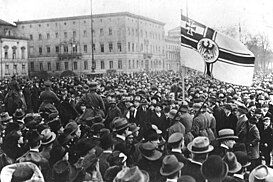
In the March 1920
Some among the working class did not limit themselves to passive resistance to the Kapp Putsch. Especially in the Ruhr, where dissatisfaction with the lack of nationalisation of key industries was particularly high, councils were formed that sought to seize local power. In the Ruhr uprising, civil war-like fighting broke when the Ruhr Red Army, made up of some 50,000 armed workers, mostly adherents of the KPD and USPD, used the disruption caused by the general strike to take control of the industrial district. After bloody battles in which an estimated 1,000 insurgents and 200 soldiers died, Reichswehr and Freikorps units suppressed the revolt in early April.[93]
In Bavaria the Kapp Putsch led to an anti-republican government reshuffle that made the Free State a so-called "cell of order" (Ordnungszelle) within the Weimar state and a rallying point for right-wing conservative and reactionary forces.[94] The unstable political conditions in the early phase of the Weimar Republic were also evident in the Reichstag elections of 1920, in which the centre-left Weimar Coalition, which until then had had a three-quarters majority, lost 125 seats to parties on both the left and right.[95]
Political assassinations
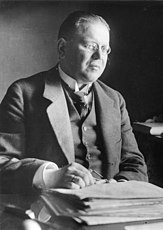
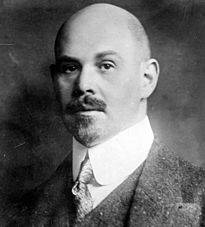
The sharp political polarisation that had occurred was visible in the assassinations of important representatives of the Republic by members of the right-wing extremist Organisation Consul. Finance Minister Matthias Erzberger was assassinated in August 1921 and Foreign Minister Walther Rathenau in June 1922. Both men had been defamed as compliant to Germany's former enemies in the matter of reparations payments. Erzberger was also attacked for signing the armistice agreement in 1918, and Rathenau had sought to break Germany's external isolation after the First World War through the Treaty of Rapallo, which opened diplomatic relations with the new Soviet Union, renounced all war claims and mutually cancelled pre-war debts. Rathenau also attracted right-wing extremist hatred because he was a Jew. The passing of the Law for the Protection of the Republic, which increased the punishments for politically motivated acts of violence, established a special court for the protection of the Republic and prohibited organizations, printed material and rallies that opposed the constitutional republican form of government, was intended to put a stop to the Republic's right-wing enemies. The conservative judiciary from the imperial era that still remained in place and passed lenient sentences against right-wing state criminals contributed to the fact that their activities could not be permanently deterred.[96]
Reparations and the occupation of the Ruhr
After a series of international conferences to determine the reparations for which Germany was liable, an amount of 132 billion Reichsmarks was presented in May 1921, to be paid either in gold or commodities such as iron, steel and coal.[97] Chancellor Joseph Wirth had no choice other than to accept, but in an attempt to have the amount lowered, he began the German policy of "fulfilment" (Erfüllungspolitik). By attempting to meet the payments, it intended to show the Allies that the demands were beyond Germany's economic means.[98] In May 1922, when the Reichsmark was rapidly losing value, Germany was granted a payment moratorium over strong French objections.[97]
In January 1923 France declared Germany in default. The French minister president Raymond Poincaré saw Germany's failure to pay reparations as a lever that he could use to achieve the separation of the Rhineland from the German Reich, a French demand that had been refused by the British at Versailles.[99] After the Reparation Commission determined that German coal deliveries were short, French and Belgian troops on 11 January 1923 marched into the Rhineland,[98] Germany's most productive industrial region, and took control of most of its mining and manufacturing companies. The German government under Chancellor Wilhelm Cuno responded with a policy of non-violent passive resistance to the occupation. It underwrote the costs of idled factories and mines and paid the workers who were on strike. Unable to meet the enormous costs by any other means, it resorted to printing money. Along with the debts the state had incurred during the war, it was one of the major causes of the hyperinflation that followed.[100]
Realizing that continuing the course was untenable, the new Reich Chancellor
Hyperinflation
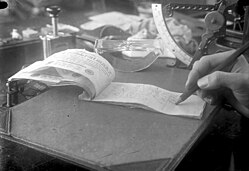
The hyperinflation fueled by the government's response to the occupation of the Ruhr caused the cost of a loaf of bread to rise from 3 Reichsmarks in 1922 to 80 billion Reichsmarks in November 1923. Prices were rising so rapidly that people rushed to spend their pay at lunch breaks before it lost any more of its value. Foreign trade became all but impossible, as did German ability to pay reparations.[102] While personal savings became virtually worthless, so did fixed debts. Middle class owners of land or houses often came out ahead because their debts lost value along with the currency. Large industrial concerns profited in the same manner, and wealth concentrated in fewer hands.[66] The classic example was Hugo Stinnes, who earned the title of Inflation King by taking advantage of its effects on debt to amass controlling interests in 1,535 businesses with 2,890 different plants by 1924.[103] Stinnes' empire collapsed after the government-sponsored inflation was stopped by the introduction of the Rentenmark on 15 November 1923. One U.S. dollar was equivalent to 4.20 Rentenmarks; the exchange rate was 1 Rentenmark to one trillion paper marks. The new money was backed by the Reich's gold reserves along with a 3.2 billion Rentenmark mortgage on the land holdings of agriculture, industry and trade. The introduction of the Rentenmark was successful at stabilizing German currency and the economy.[104]
Additional political violence and the Hitler putsch
With the proclamation on 21 October 1923 of the Rhenish Republic came a short-lived secessionist movement in the wake of which sections of the labour force became increasingly radicalized. In Saxony and Thuringia, Communists won enough seats to participate in governments under Social Democratic minister presidents. In both states the Communists were expelled by Reich executions (Reichsexekutionen) using Article 48 of the Weimar Constitution. In the Reichstag, the Social Democrats withdrew their support from Cuno's government and entered a grand coalition under DVP Chancellor Gustav Stresemann.[105]
The nationalist right, especially in Bavaria, branded the breaking off of the Ruhr resistance as treason. In a breach of the Weimar constitution, Bavaria declared a state of emergency, and executive power was transferred to Gustav Ritter von Kahr as state commissioner general. The Reichswehr under the Chief of Army Command, General Hans von Seeckt, who had his own governmental ambitions directed against left-wing parties and Weimar parliamentarism,[106] behaved loyally towards the Stresemann government only with respect to his own interests. In spite of the moves against the governments in Saxony and Thuringia, no action was taken against Bavaria, where Kahr was preparing a military coup aimed at overthrowing the Reich government in cooperation with the Bavarian military under district commander Otto von Lossow.[107]
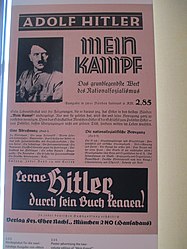
In 1920 the
Golden Era (1924–1929)
From 1924 to 1929, the Weimar Republic was relatively stable. Known in Germany as the "Goldene Zwanziger" (Golden Twenties), its prominent features were internal consolidation and rapprochement in foreign affairs, along with a growing economy and a consequent decrease in civil unrest, although the improvements came about without establishing a sustainable foundation for the parliamentary democracy. While Germany's recognition of its reparations obligations promoted reintegration into the contemporary state system and world markets, it also developed a strong dependence on American capital. The stability was partly borrowed and, in the end, only superficial.[110]
Framework for economic policy
An essential basis for the relative stabilisation was the restructuring of reparations through the Dawes Plan.[111] Without fixing a final total sum, the plan regulated the scope, composition and the security of transfers for future annual reparations payments. The latter was to be guaranteed by the American financial expert Parker Gilbert who, as reparations agent, could directly influence German fiscal and financial policy in order to secure monetary stability. The acceptance of the Dawes Plan in the Reichstag had long been uncertain – parts of the Right spoke of a "new enslavement of the German people" and the KPD of the enslavement of the German proletariat.[99] Once the plan had been passed, it brought the Weimar Republic a significant inflow of American loans from state funds as well as private investors. The money served as both start-up financing for reparations and as aid for an economic revival. German railways, the National Bank and many industries were mortgaged as security for the loans.[112]
The economic consolidation that occurred after the period of hyperinflation was largely at the expense of wage earners and the economic middle class. The eight-hour day, one of the main social achievements of the 1918/19 revolution, was in many cases watered down or abandoned; the civil service was affected by massive job cuts and salary reductions; and rationalisation and concentration in large industries continued and deprived many small and medium-sized enterprises of their livelihoods. Savers and creditors who had been hurt by inflation were effectively left without any significant compensation.[113]
The declarations of social guarantees contained in the Weimar Constitution[114] had only a limited effect and stood in striking contrast to the many experiences of social decline. From 1924 onwards, small savers who had been impoverished or economically ruined by inflation were at least able to take advantage of the state-organised social welfare system, which replaced the former poor relief. The new system, however, was characterised by "petty means tests under an anonymous social bureaucracy" and by benefits that only secured existence at a subsistence level.[115] In the brief peak phase of overall economic recovery and economic optimism, unemployment insurance was introduced in 1927. In some respects it was the "high point of the Republic's social expansion", although it benefitted only a portion of the workforce and did not cover permanent unemployment.[116] In the meantime, the state had also introduced a new system of social security.
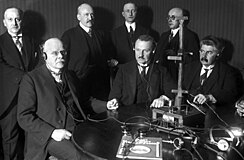
The parliamentary system of Weimar democracy was the expression of a party landscape that was strongly characterised and fragmented by class and social milieus. Reichstag members as representatives of the interests of their respective electorates often had narrow limits to their willingness to compromise. Such class and status consciousness was part of the legacy of the imperial era and continued to have an effect, although it was also partly reshaped by a consumer and leisure-oriented mass culture that emerged in the 1920s and was driven by the new media forms of records, film and radio. People of all classes and strata went to the cinema or sat in front of the radio. Mass culture pointed in the direction of democratisation and was interpreted by conservatives as intellectual flattening and a decline in values. The class fronts were gradually softened by mass culture, marking a "class society in transition".[117]
Unstable political system
After Reich President Ebert died at the beginning of 1925 at the age of 54, the candidate of the parties that supported the Republic, Wilhelm Marx of the Centre Party, was defeated in the second round of the 1925 Reich presidential election by the candidate of the nationalist right, Paul von Hindenburg, 48.3% to 45.3%. Despite the fact that Hindenburg had declared in advance that he intended to hold office in accordance with the Weimar Constitution,[118] his electoral success showed how far the country had shifted to the right since Weimar's beginnings with a socialist president.
The Reichstag elections in May 1924 and December 1924 were once again failures for the Weimar Coalition (SDP, DDP and Centre), which had started so comfortably in 1919 and which maintained its position as a "bulwark of democracy" only in Prussia.[119] In the May election, the Coalition partners lost a total of 13 seats, while the right wing DNVP and left wing KPD picked up 82 seats. After the SPD left Gustav Stresemann's cabinet in November 1923 in protest of the Reich executions against Saxony and Thuringia, it did not take part in a government again until June 1928. From 1924 to 1928, there were three chancellors: Wilhelm Marx of the Centre party (twice), the non-partisan Hans Luther and Hermann Müller of the SPD. Altogether there were seven cabinets under the three men.
Foreign policy
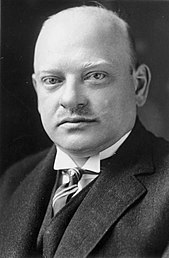
Despite the frequent changes of personnel in the Reich chancellery and in the government cabinets between 1923 and 1928, there was nevertheless an effective constant in Foreign Minister Gustav Stresemann of the German People's Party. With his change from "monarchist of the heart" to "republican of reason",[120] as he himself expressed it, Stresemann exercised a stabilising influence on the political development of the Republic not only as Reich chancellor in 1923 but throughout the entire period of his participation in government.
He sought a release from the restraints of the Treaty of Versailles exclusively by peaceful means and through mutual understanding, although without abandoning long-term revisionist intentions such as regaining the territory ceded to Poland. He took the initiative for the 1925 Locarno Treaties, which settled Germany's western borders but left the issue of the eastern ones open. Through reaching an understanding with France and securing Germany an equal position in the League of Nations in 1926, he led the Weimar Republic out of isolation. Germany signed arbitration conventions with France and Belgium and arbitration treaties with Poland and Czechoslovakia, undertaking to refer any future disputes to an arbitration tribunal or to the Permanent Court of International Justice.[121] As a result of the Dawes Plan, foreign troops left the Ruhr in 1925.[122] In addition, the 1926 Treaty of Berlin ensured that relations with the Soviet Union remained unencumbered. Beginning in1925 there was secret and illegal cooperation between the Reichswehr and the Red Army. Germany tested weapons in the Soviet Union that had been banned by the Treaty of Versailles, including aircraft, tanks and poison gas.[123]
The favourable effects expected from the Locarno Treaties were to a certain extent realized. The first Rhineland zone was vacated in 1925, Franco-German economic relations were expanded through agreements, and the Military Inter-Allied Commission of Control, which monitored German disarmament, left Germany in 1927. In 1928 Stresemann played an important mediating role between the USA and France in the negotiations on the Kellogg–Briand Pact, an international agreement on peace.[124]
After the full reparations schedule under the Dawes Plan was drawn up in 1928/29, new negotiations took place. In the resulting
Culture
The 1920s saw a remarkable cultural renaissance in Germany. During the worst phase of hyperinflation in 1923, the clubs and bars were full of speculators who spent their daily profits so they would not lose the value the following day. Berlin intellectuals responded by condemning the excesses of what they considered capitalism and demanding revolutionary changes on the cultural scenery.
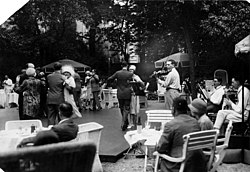
Influenced by the brief cultural explosion in the Soviet Union, German literature, cinema, theatre and musical works entered a phase of great creativity. Innovative street theatre brought plays to the public, and the

Artists in Berlin were influenced by other contemporary progressive cultural movements, such as the Impressionist and Expressionist painters in Paris, as well as the Cubists. Likewise, American progressive architects were admired. Many of the new buildings built during this era followed a straight-lined, geometrical style. Examples of the new architecture include the Bauhaus Building by Gropius, Grosses Schauspielhaus, and the Einstein Tower.[127]
Not everyone, however, was happy with the changes taking place in Weimar culture. Conservatives and reactionaries feared that Germany was betraying its traditional values by adopting popular styles from abroad, particularly those Hollywood was popularising in American films, while New York became the global capital of fashion.
In 1929, three years after receiving the 1926 Nobel Peace Prize, Stresemann died of a heart attack at age 51. When the New York Stock Exchange crashed in October 1929, American loans dried up and the sharp decline of the German economy brought the "Golden Twenties" to an abrupt end.
Social policy under Weimar
A wide range of progressive social reforms were carried out during and after the revolutionary period. The Executive Council of the Workers' and Soldiers' Councils – a coalition that included Majority Social Democrats, Independent Social Democrats, workers and soldiers – introduced the eight-hour work day, reinstated demobilised workers, released political prisoners, abolished press censorship, increased workers' old-age, sick and unemployment benefits, and gave labour the unrestricted right to organise into unions.[128] It was made harder for estates to sack workers and prevent them from leaving when they wanted to. Under the Provisional Act for Agricultural Labour of 23 November 1918, the normal period of notice for management and most resident labourers was set at six weeks. In addition, a supplementary directive of December 1918 specified that female and child workers were entitled to a fifteen-minute break if they worked between four and six hours, thirty minutes for workdays lasting six to eight hours, and one hour for longer days.[129] A decree on 23 December 1918 established committees (composed of workers' representatives "in their relation to the employer") to safeguard the rights of workers. The right to bargain collectively was also established, while it was made obligatory "to elect workers' committees on estates and establish conciliation committees". A decree on 3 February 1919 removed the right of employers to acquire exemption for domestic servants and agricultural workers.[130] In 1919, legislation provided for a maximum working 48-hour workweek, restrictions on night work, a half-holiday on Saturday, and a break of thirty-six hours of continuous rest during the week.[131]
With the decree of 3 February 1919, the Ebert government reintroduced the original structure of the health insurance boards according to an 1883 law, with one-third employers and two-thirds workers.[132] As of 28 June 1919, health insurance committees were elected by the workers themselves.[133] That same year, health insurance was extended to wives and daughters without their own income, people only partially capable of gainful employment, people employed in private cooperatives, and people employed in public cooperatives.[134]
The Provisional Order of January 1919 concerning agricultural labour conditions fixed 2,900 hours as a maximum per year, distributed as eight, ten, and eleven hours per day in four month periods.[135] A code of January 1919 bestowed on land labourers the same legal rights that industrial workers enjoyed, while a bill ratified the same year obligated the states to set up agricultural settlement associations which "were endowed with the priority right of purchase of farms beyond a specified size".[136]
A series of progressive tax reforms were introduced under the auspices of Matthias Erzberger, including increases in taxes on capital[137] and an increase in the highest income tax rate from 4% to 60%.[138] Under a governmental decree of 3 February 1919, the German government met the demand of the veterans' associations that all aid for the disabled and their dependents be taken over by the central government[139] (thus assuming responsibility for this assistance) and extended into peacetime the nationwide network of state and district welfare bureaus that had been set up during the war to coordinate social services for war widows and orphans.[140]
The Youth Welfare Act of 1922 obliged all municipalities and states to set up youth offices in charge of child protection, and also codified a right to education for all children,[141] while laws were passed to regulate rents and increase protection for tenants in 1922 and 1923.[142] Health insurance coverage was extended to other categories of the population during the existence of the Weimar Republic, including seamen, people employed in the educational and social welfare sectors, and all primary dependents.[134] Various improvements were also made in unemployment benefits, although in June 1920 the maximum amount of unemployment benefit that a family of four could receive in Berlin, 90 marks, was well below the minimum cost of subsistence of 304 marks.[143]
In 1923, unemployment relief was consolidated into a regular programme of assistance following economic problems that year. In 1924, a modern public assistance programme was introduced, and in 1925 the accident insurance programme was reformed, allowing diseases that were linked to certain kinds of work to become insurable risks. In addition, a national unemployment insurance programme was introduced in 1927.[144] Housing construction was also greatly accelerated during the Weimar period, with over 2 million new homes constructed between 1924 and 1931 and a further 195,000 modernised.[145]
Renewed crisis and decline (1930–1933)
Onset of the Great Depression
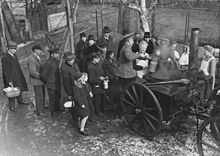

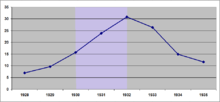
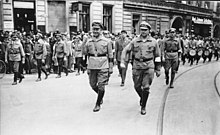
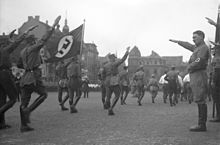
In 1929, the onset of the
Brüning and the first presidential cabinet (1930–1932)
On 29 March 1930, at the instigation of General Kurt von Schleicher, President Paul von Hindenburg appointed finance expert Heinrich Brüning as successor to Hermann Müller (SPD),[149] whose five-party coalition had broken down on 27 March over how to finance the increased costs of unemployment compensation. The new government was expected to lead a political shift towards conservatism.
As Brüning had no majority support in the Reichstag, he became, through the use of the emergency powers granted to the Reich president by Article 48 of the constitution, the first Weimar chancellor to operate independently of parliament.[6] After a bill to reform Germany's finances was opposed by the Reichstag, it was made into an emergency decree by Hindenburg. On 18 July, as a result of opposition from the SPD, KPD, DNVP and the small contingent of NSDAP members, the Reichstag again rejected the bill by a slim margin. Immediately afterward, Brüning submitted a decree from the President to dissolve the Reichstag.[150] The consequent general election on 14 September resulted in an enormous political shift within the Reichstag: 18.3% of the vote went to the NSDAP, five times the percentage it had won in 1928.[151] As a result, it was no longer possible, even with a grand coalition, to form a pro-republican majority that excluded the KPD, DNVP and NSDAP. The situation led an increase in the number of public demonstrations and instances of paramilitary violence organised by the NSDAP.
Between 1930 and 1932, Brüning enacted a policy of deflation and drastic cuts in state expenditures.[6] Among other measures, he completely halted all obligatory public payments to the unemployment insurance program introduced in 1927, resulting in higher contributions from the workers and fewer benefits for the unemployed. Benefits for the sick, invalids and pensioners were also sharply reduced.[152] He triggered a deflationary internal devaluation by forcing the economy to reduce prices, rents, salaries and wages by 20%[10] since the Young Plan did not allow the Reichsmark to be devalued.
By late 1931 Hindenburg and Schleicher had begun to contemplate dropping Brüning in favour of accommodating Alfred Hugenberg of the DNVP and Adolf Hitler. On 30 May 1932, Brüning finally lost Hindenburg's support over the question of Eastern Aid and resigned as chancellor.
The consensus today is that Brüning's policies exacerbated the German economic crisis and the population's growing frustration with democracy, contributing considerably to the increase in support for Hitler's NSDAP.[6]
Papen cabinet
Hindenburg then appointed Franz von Papen as the new chancellor. He was closely associated with the industrialist and land-owning classes and the military. General Kurt von Schleicher – who himself became Reichswehr minister – handpicked the members of the Papen cabinet, which came to be known as the "Cabinet of Barons".[153] It continued to govern by presidential decree as had the Brüning cabinets.
On 16 June Papen lifted the ban on the Nazi Sturmabteilung (SA) and Schutzstaffel (SS)[154] that had been imposed on 13 April under the Brüning government.[155] Using the political violence that took place during the Reichstag election campaign as a pretext, he ousted the SPD-led coalition government of Prussia in the Prussian coup d'état (Preußenschlag) of 20 July. By emergency decree he declared himself Reich Commissioner (Reichskommissar) of Prussia, a step that further weakened the democracy of the Weimar Republic.[156]
Elections of July 1932
Per a prior agreement with Hindenburg and Hitler, Papen had dissolved the Reichstag on 4 June 1932 and called for new elections in the hope that the Nazi Party would win the most seats and allow him to set up an authoritarian government.
The immediate question was what part the Nazi Party would play in the government of the country. Hitler refused a ministry under Papen and demanded the chancellorship for himself but was rejected by Hindenburg on 13 August 1932. Since there was still no majority in the Reichstag for any government, the Reichstag was again dissolved, and elections took place in the hope that a stable majority would result.[97]
Schleicher cabinet
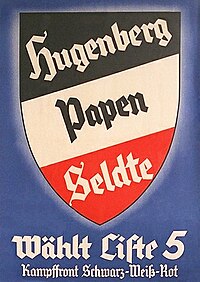
In this brief Presidential Dictatorship intermission, Schleicher assumed the role of "Socialist General" and entered into relations with the Christian Trade Unions, the relatively left of the Nazi party, and even with the Social Democrats. Schleicher planned for a sort of labour government under his Generalship. But the Reichswehr officers were not prepared for this, the working class had a natural distrust of their future allies, and the great capitalists and landowners also did not like the plans.
Hitler learned from Papen that the general had not received from Hindenburg the authority to abolish the Reichstag parliament, whereas any majority of seats did. The cabinet (under a previous interpretation of Article 48) ruled without a sitting Reichstag, which could vote only for its own dissolution. Hitler also learned that all past crippling Nazi debts were to be relieved by German big business.
On 22 January, Hitler's efforts to persuade Oskar von Hindenburg, the President's son and confidant, included threats to bring criminal charges over estate taxation irregularities at the President's Neudeck estate; although 5,000 acres (20 km2) extra were soon allotted to Hindenburg's property. Outmaneuvered by Papen and Hitler on plans for the new cabinet, and having lost Hindenburg's confidence, Schleicher asked for new elections. On 28 January, Papen described Hitler to Paul von Hindenburg as only a minority part of an alternative, Papen-arranged government. The four great political movements, the SPD, Communists, Centre, and the Nazis were in opposition.
On 29 January, Hitler and Papen thwarted a last-minute threat of an officially sanctioned Reichswehr takeover, and on 30 January 1933 Hindenburg accepted the new Papen-Nationalist-Hitler coalition, with the Nazis holding only three of eleven Cabinet seats: Hitler as Chancellor, Wilhelm Frick as Minister of the Interior and Hermann Göring as Minister Without Portfolio. Later that day, the first cabinet meeting was attended by only two political parties, representing a minority in the Reichstag: The Nazis and the German National People's Party (DNVP), led by Alfred Hugenberg, with 196 and 52 seats respectively. Eyeing the Catholic Centre Party's 70 (plus 20 BVP) seats, Hitler refused their leader's demands for constitutional "concessions" (amounting to protection) and planned for dissolution of the Reichstag.
Hindenburg, despite his misgivings about the Nazis' goals and about Hitler as a personality, reluctantly agreed to Papen's theory that, with Nazi popular support on the wane, Hitler could now be controlled as Chancellor. This date, dubbed by the Nazis as the
End of the Weimar Republic
Hitler's chancellorship (1933)
Hitler was sworn in as Chancellor on the morning of 30 January 1933 in what some observers later described as a brief and indifferent ceremony. By early February, a mere week after Hitler's assumption of the chancellorship, the government had begun to clamp down on the opposition. Meetings of the left-wing parties were banned and even some of the moderate parties found their members threatened and assaulted. Measures with an appearance of legality suppressed the Communist Party in mid-February and included the plainly illegal arrests of Reichstag deputies.
On 27 February 1933 the Reichstag was gutted by fire, which was blamed on an act of arson by Dutch council communist Marinus van der Lubbe. However, in 2019, an affidavit that had been concealed by a prominent Nazi era German historian was uncovered. In the affidavit from the 1950s, a former member of the Nazis' paramilitary SA unit swore that on the night of the Reichstag fire, he was part of an SA group that drove Van der Lubbe from an infirmary to the Reichstag, where they noticed "a strange smell of burning and there were clouds of smoke billowing through the rooms". The fire already being set when der Lubbe was forcefully brought there by the SA, as well as the Nazi government's immediate use of the event to seize power, has led many contemporary historians to validate that the SA played a role in the arson, as a false flag attack.[160] Hitler blamed the fire on the KPD (though Van der Lubbe was not a member of the party) and convinced Hindenburg to issue the Reichstag Fire Decree the following day. The decree invoked Article 48 of the Weimar Constitution and "indefinitely suspended" a number of constitutional protections of civil liberties, allowing the Nazi government to take swift action against political meetings, arresting and killing the Communists.
Hitler and the Nazis exploited the German state's broadcasting and aviation facilities in a massive attempt to sway the electorate, but this election yielded a scant majority of 16 seats for the NSDAP-DNVP coalition. At the
Hitler addressed disparate interest groups, stressing the necessity for a definitive solution to the perpetual instability of the Weimar Republic. He now blamed Germany's problems on the Communists, even threatening their lives on 3 March. Former Chancellor Heinrich Brüning proclaimed that his Centre Party would resist any constitutional change and appealed to the President for an investigation of the Reichstag fire. Hitler's successful plan was to induce what remained of the now Communist-depleted Reichstag to grant him, and the Government, the authority to issue decrees with the force of law. The hitherto Presidential Dictatorship hereby was to give itself a new legal form.
On 15 March, the first
Hitler cabinet meeting in mid-March
At the cabinet meeting on 15 March, Hitler introduced the Enabling Act, which would have authorised the cabinet to enact legislation without the approval of the Reichstag. Meanwhile, the only remaining question for the Nazis was whether the Catholic Centre Party would support the Enabling Act in the Reichstag, thereby providing the 2⁄3 majority required to ratify a law that amended the constitution. Hitler expressed his confidence to win over the Centre's votes. Hitler is recorded at the Nuremberg Trials as being sure of eventual Centre Party Germany capitulation and thus rejecting of the DNVP's suggestions to "balance" the majority through further arrests, this time of Social Democrats. Hitler, however, assured his coalition partners that arrests would resume after the elections and, in fact, some 26 Social Democrats were physically removed. After meeting with Centre leader Monsignor Ludwig Kaas and other Centre Trade Union leaders daily and denying them a substantial participation in the government, negotiation succeeded in respect of guarantees towards Catholic civil-servants and education issues.
At the last internal Centre meeting prior to the debate on the Enabling Act, Kaas expressed no preference or suggestion on the vote, but as a way of mollifying opposition by Centre members to the granting of further powers to Hitler, Kaas somehow arranged for a letter of constitutional guarantee from Hitler himself prior to his voting with the Centre en bloc in favour of the Enabling Act. This guarantee was not ultimately given. Kaas, the party's chairman since 1928, had strong connections to the Vatican Secretary of State, later Pope Pius XII. In return for pledging his support for the act, Kaas would use his connections with the Vatican to set in train and draft the Holy See's long desired Reichskonkordat with Germany (only possible with the co-operation of the Nazis).
Ludwig Kaas is considered along with Papen as being one of the two most important political figures in the creation of the Nazi regime.[162]
Enabling Act negotiations
On 20 March, negotiation began between Hitler and Frick on one side and the Catholic Centre Party (Zentrum) leaders—Kaas, Stegerwald, and Hackelsburger on the other. The aim was to settle on conditions under which Centre would vote in favour of the Enabling Act. Because of the Nazis' narrow majority in the Reichstag, the Centre's support was necessary to receive the required two-thirds majority vote. On 22 March, the negotiations concluded; Hitler promised to continue the existence of the German states, agreed not to use the new grant of power to change the constitution, and promised to retain Centre Party members in the civil service. Hitler also pledged to protect the Catholic confessional schools and to respect the concordats signed between the Holy See and Bavaria (1924), Prussia (1929), and Baden (1931). Hitler also agreed to mention these promises in his speech to the Reichstag before the vote on the Enabling Act.
The ceremonial opening of the Reichstag on 21 March was held at the Garrison Church in Potsdam, a shrine of Prussianism, in the presence of many Junker landowners and representatives of the imperial military caste. This impressive and often emotional spectacle—orchestrated by Joseph Goebbels—aimed to link Hitler's government with Germany's imperial past and portray Nazism as a guarantor of the nation's future. The ceremony helped convince the "old guard" Prussian military elite of Hitler's homage to their long tradition and, in turn, produced the relatively convincing view that Hitler's government had the support of Germany's traditional protector—the Army. Such support would publicly signal a return to conservatism to curb the problems affecting the Weimar Republic, and that stability might be at hand. In a cynical and politically adroit move, Hitler bowed in apparently respectful humility before President and Field Marshal Hindenburg.
Passage of the Enabling Act
The Reichstag convened on 23 March 1933 at the
Hitler promised that the Act did not threaten the existence of either the Reichstag or the Reichsrat, that the authority of the President remained untouched and that the states would not be abolished. During an adjournment, the other parties (notably the Centre) met to discuss their intentions.[164]
In the debate prior to the vote on the Enabling Act, Hitler orchestrated the full political menace of his paramilitary forces like the Storm Troopers in the streets to intimidate reluctant Reichstag deputies into approving the Enabling Act. The Communists' 81 seats had been empty since the Reichstag Fire Decree and other lesser known procedural measures, thus excluding their anticipated "No" votes from the balloting. Otto Wels, the leader of the Social Democrats, whose seats were similarly depleted from 120 to below 100, was the only speaker to defend democracy and in a futile but brave effort to deny Hitler the 2⁄3 majority, he made a speech critical of the abandonment of democracy to dictatorship. At this, Hitler could no longer restrain his wrath.[165]
In his retort to Wels, Hitler abandoned earlier pretence at calm statesmanship and delivered a characteristic screaming diatribe, promising to exterminate all Communists in Germany and threatening Wels' Social Democrats as well. He did not even want their support for the bill. "Germany will become free, but not through you," he shouted.[166] Meanwhile, Hitler's promised written guarantee to Monsignor Kaas was being typed up, it was asserted to Kaas, and thereby Kaas was persuaded to silently deliver the Centre bloc's votes for the Enabling Act anyway. The Act—formally titled the "Act for the Removal of Distress from People and Reich"—was passed by a vote of 444 to 94. Only the SPD had voted against the Act. Every other member of the Reichstag, whether from the largest or the smallest party, voted in favour of the Act. It went into effect the following day, 24 March.
Consequences
The passage of the
The constitution of 1919 was never formally repealed, but the Enabling Act meant that it was a dead letter. The Reichstag was effectively eliminated as an active player in German politics. It only met sporadically until the end of World War II, held no debates and enacted only a few laws; for all purposes, it was reduced to a mere stage for Hitler's speeches. The other chamber of the German parliament (the Reichsrat) was officially abolished on 14 February 1934 by the "Law on the Abolition of the Reichsrat"; this decision was in clear violation of the Enabling Act, which stipulated that any laws passed under its authority could not affect the institutions of either chamber. By this time, however, the Nazis had become law unto themselves, and these actions were never challenged in court.
On 2 August 1934, Hindenburg died from lung cancer, thus eliminating any remaining obstacle to Nazi full dominance; the day before his death, the Hitler Cabinet passed the "
Reasons for failure
This section needs additional citations for verification. Relevant discussion may be found on the talk page. Please help improve this article by adding citations to reliable sources in this section. Unsourced material may be challenged and removed. Find sources: "Weimar Republic" decline – news · newspapers · books · scholar · JSTOR (June 2021) (Learn how and when to remove this template message) |
The reasons for the Weimar Republic's collapse are the subject of continuing debate. It may have been doomed from the beginning since even moderates disliked it and extremists on both the left and right loathed it, a situation often referred to as a "democracy without democrats".[167] Germany had limited democratic traditions, and Weimar democracy was widely seen as chaotic. Since Weimar politicians had been blamed for the Dolchstoß ("stab-in-the-back"), a widely believed theory that Germany's surrender in the First World War had been the unnecessary act of traitors, the popular legitimacy of the government was on shaky ground. As normal parliamentary lawmaking broke down and was replaced around 1930 by a series of emergency decrees, the decreasing popular legitimacy of the government further drove voters to extremist parties.[168]
No single reason can explain the failure of the Weimar Republic. The most commonly asserted causes can be grouped into three categories: economic problems, institutional problems, and the roles of specific individuals.[169]
Economic problems
The Weimar Republic had some of the most serious economic problems ever experienced by any Western democracy in history. Rampant hyperinflation, massive unemployment, and a large drop in living standards were primary factors. From 1923 to 1929, there was a short period of economic recovery, but the Great Depression of the 1930s led to a worldwide recession. Germany was particularly affected because it depended heavily on American loans. That was made apparent when political parties on both right and left wanted to disband the Republic altogether, making any democratic majority in Parliament impossible.[169]
The Weimar Republic was severely affected by the Great Depression. The economic stagnation led to increased demands on Germany to repay the debts owed to the United States. In 1926, about two million Germans were unemployed, which rose to around six million in 1932, with many blaming the Weimar Republic. As the Weimar Republic was very fragile throughout its existence, the depression was devastating and played a major role in the Nazi takeover.
Most Germans thought the Treaty of Versailles was a punishing and degrading document because it forced them to surrender resource-rich areas and pay massive amounts of compensation. The punitive reparations caused consternation and resentment, but the actual economic damage resulting from the Treaty of Versailles is difficult to determine. While the official reparations were considerable, Germany ended up paying only a fraction of them. However, the reparations damaged Germany's economy by discouraging market loans, which forced the Weimar government to finance its deficit by printing more currency, causing rampant hyperinflation. At the beginning of 1920, one US dollar was equivalent to fifty marks. By the end of 1923, one US dollar was equal to 4,200,000,000,000 marks.[170]
In addition, the rapid disintegration of Germany in 1919 by the return of a disillusioned army, the rapid change from possible victory in 1918 from the
Institutional problems
It is widely believed that the
- The institution of the Reichspräsident was frequently considered as an Ersatzkaiser ("substitute emperor"), an attempt to replace the emperors with a similarly strong institution meant to diminish party politics. Article 48 of the Constitution gave the President power to "take all necessary steps" if "public order and security are seriously disturbed or endangered". Although it was intended as an emergency clause, it was often used before 1933 to issue decrees without the support of Parliament (see above) and also made Gleichschaltung easier.
- During the Weimar Republic, it was accepted that a law did not have to conform to the constitution as long as it had the support of two-thirds of parliament, the same majority needed to change the constitution (verfassungsdurchbrechende Gesetze). That was a precedent for the Enabling Act of 1933. The Basic Law of 1949 requires an explicit change of the wording, and it prohibits abolishing the basic rights or the federal structure of the republic.
- The use of a majority vote (under a two-round system).
- The Reichstag could remove the Reichskanzler from office even if it was unable to agree on a successor. The use of such a motion of no confidence meant that since 1932, a government could not be held in office when the parliament came together. As a result, the 1949 Grundgesetz ("Basic Law") stipulates that a chancellor may not be removed by Parliament unless a successor is elected at the same time, known as a "constructive vote of no confidence".
- The fundamental rights of habeas corpus, sanctity of the home, inviolability of the mail, freedom of speech and the press, freedom of assembly, freedom of association (including religious associations) and the inviolability of property – Articles 114, 115, 117, 118, 123, 124 and 153 of the Weimar Constitution – could be suspended under Article 48.[172] The Basic Law lists them as basic rights that cannot legally be nullified and in Article 20 (4) includes the right to resist attempts to abolish the constitutional order.[173]
Role of individuals
Chancellor Heinrich Brüning's economic policy from 1930 to 1932 has been the subject of much debate. It caused many Germans to identify the Republic with cuts in social spending and extremely liberal economics. Whether there were alternatives to this policy during the Great Depression is an open question. Brüning eventually went into exile in 1934 and ultimately ended up in the United States, where he taught political science at Harvard University from 1937 to 1952.[174]
Paul von Hindenburg became Reichspräsident in 1925. As he was an old style monarchist conservative, he had little love lost for the Republic, but for the most part, he formally acted within the bounds of the constitution.[175] However, he ultimately—on the advice of his son and others close to him—appointed Hitler chancellor, thereby effectively ending the Republic after the passage of the Enabling Act of 1933. Additionally, Hindenburg's death in 1934 ended the last obstacle for Hitler to assume full power in the Weimar Republic.
The German National People's Party (DNVP) has also been blamed as responsible for the downfall of the Weimar Republic because of its ultranationalist positions and its unwillingness of accepting the Republic because of its monarchist ideology. In his book, The Rise and Fall of the Third Reich, journalist and historian William L. Shirer wrote that the DNVP's status as a far-right party rather than a mainstream conservative party was one of the main reasons for the Weimar Republic's downfall. In Shirer's view, the DNVP's refusal to "take a responsible position either in the government or in the opposition" during most of Weimar's existence denied Weimar "that stability provided in many other countries by a truly conservative party."[178] Similarly, conservative British historian Sir John Wheeler-Bennett blamed the DNVP for failing to reconcile with the Republic, stating that "Under the cloak of loyalty to the Monarchy, they either held aloof or sabotaged the efforts of successive Chancellors to give a stable government to the Republic. The truth is that after 1918 many German Nationalists were more influenced by feelings of disloyalty to the Republic than of loyalty to the Kaiser, and it was this motive which led them to make their fatal contribution to bringing Hitler to power".[179]
Legacy
According to Foreign Policy, the Weimar Republic is seen as "the best-known historical example of a 'failed' democracy that ceded to fascism".[182]
Constituent states
Prior to the First World War, the constituent states of the German Empire were 22 smaller monarchies, three republican city-states, and the Imperial Territory of Alsace–Lorraine. After the territorial losses of the Treaty of Versailles and the German Revolution of 1918–1919, the remaining states continued as republics. The former Ernestine duchies continued briefly as republics before merging to form the state of Thuringia in 1920, except for Saxe-Coburg, which became part of Bavaria.
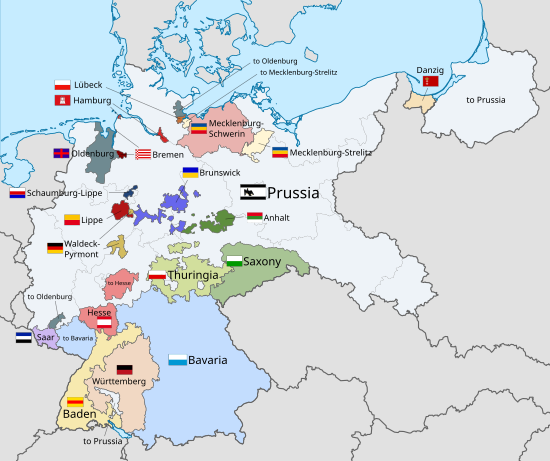 |
| ||||||||||||||||||||||||||||||||||||||||||||||||||||||||||||||||||||||||||||||||||||||||||
These states were gradually abolished under the Nazi regime via the
See also
- Timeline of the Weimar Republic
- Württemberg Landtag elections in the Weimar Republic
- Democracy in Europe
References
Explanatory notes
- ^ Kaliningrad Oblast
- ^ German: Weimarer Republik, [ˈvaɪmaʁɐ ʁepuˈbliːk] ⓘ
- ^ German: Deutsches Reich
- ^ German: Deutsche Republik
- ^ While Germany fulfilled most of its treaty obligations, it never completely disarmed, and paid only a small portion of war reparations (by twice restructuring its debt through the Dawes Plan and the Young Plan).
- ^ During the time of the Weimar Republic,
terms such as People's State were used by republican movements across the political spectrum. It was only during and after World War IIthat such terminology became more specifically associated with socialist and Communist regimes.
Citations
- Britannica Blog. Archived from the originalon 11 March 2019. Retrieved 30 March 2017.
- DW.com. 23 March 2013. Archivedfrom the original on 7 September 2019. Retrieved 30 March 2017.
- ^ Mason, K. J. Republic to Reich: A History of Germany 1918–1945. McGraw-Hill.
- ^ Winfried Klein (14 September 2012). "Wer sind wir, und was wollen wir dazu singen?". FAZ.NET. Frankfurter Allgemeine Zeitung. Retrieved 4 August 2022.
- ^ Volume 6. Weimar Germany, 1918/19–1933 Population by Religious Denomination (1910–1939) Archived 9 August 2016 at the Wayback Machine Sozialgeschichtliches Arbeitsbuch, Volume III, Materialien zur Statistik des Deutschen Reiches 1914–1945, edited by Dietmar Petzina, Werner Abelshauser and Anselm Faust. Munich: Verlag C. H. Beck, 1978, p. 31. Translation: Fred Reuss.
- ^ ISBN 1-85109-633-7, p. 185
- ^ a b "Das Deutsche Reich im Überblick". Wahlen in der Weimarer Republik. Archived from the original on 21 November 2019. Retrieved 26 April 2007.
- ^ "Kaiser Wilhelm II". HISTORY. August 2019. Archived from the original on 10 October 2021. Retrieved 10 October 2021.
- ^ Marks, Sally (1976). The Illusion of Peace: International Relations in Europe, 1918–1933, St. Martin's, New York, pp. 96–105.
- ^ ISBN 978-3-608-94308-5.
- ^ "Weimar Republic". Encyclopedia Britannica. Archived from the original on 3 May 2015. Retrieved 29 June 2012.
- ^ "Verfassungen des Deutschen Reichs (1918–1933)" [Constitution of the German Reich (1918–1933)]. Verfassungen der Welt (in German). Retrieved 4 November 2023.
- ^ a b Schnurr, Eva-Maria (30 September 2014). "Der Name des Feindes: Warum heißt die erste deutsche Demokratie eigentlich 'Weimarer Republik?'" [The Name of the Enemy: Why Was the First German Democracy Even Called the "Weimar Republic"?]. Der Spiegel (in German). Retrieved 11 June 2020.
- ^ a b c Sebastian Ullrich [de] as quoted in Schnurr 2014
- ISBN 978-1-101-04267-0.
- ^ "Constitution of the Weimar Republic". documentArchiv.de (in German). 11 August 1919. article 3. Archived from the original on 27 November 2019. Retrieved 24 February 2008.
- ^ a b Treaty of Versailles/Part V – via Wikisource.
- ISBN 9783486587364.
- ^ Kolb, Eberhard (2002). Die Weimarer Republik [The Weimar Republic] (in German) (6th ed.). Munich: Oldenbourg. p. 42.
- ^ Llewellyn, Jennifer; Thompson, Steve (5 November 2019). "Hans von Seeckt". Alpha History. Retrieved 20 March 2023.[permanent dead link]
- ISBN 978-1-4039-1812-3.
- ISBN 978-1400855346.
- ISBN 9783486580990.
- ^ Hansen 2007, p. 150–167.
- ^ Mommsen, Hans (1997). "Militär und zivile Militarisierung in Deutschland 1914 bis 1938" [Military and Civil Militarization in Germany 1914 to 1938]. In Frevert, Ute (ed.). Militär und Gesellschaft im 19. und 20. Jahrhundert [Military and Society in the 19th and 20th Centuries] (in German). Stuttgart: Klett-Cotta. p. 273.
- ^ "World War I – Killed, wounded, and missing". Encyclopedia Britannica. Archived from the original on 5 October 2020. Retrieved 7 January 2021.
- ISBN 9781854107664.
- ^ Grebler, Leo (1940). The Cost of the World War to Germany and Austria-Hungary. New Haven: Yale University Press. p. 78.
- ^ Vincent, C. Paul (1985). The Politics of Hunger: The Allied Blockade of Germany, 1915–1919. Athens (Ohio) and London: Ohio University Press.
- ^ "The National Archives – Exhibitions & Learning online – First World War – Spotlights on history". Government of the United Kingdom. Archived from the original on 6 April 2018. Retrieved 14 April 2018.
{{cite web}}: CS1 maint: bot: original URL status unknown (link) - OCLC 34996156.
- OCLC 162257288.
- ^ "Die Revolution von 1918/19". Deutsches Historisches Museum (in German). 15 August 2015. Retrieved 23 March 2023.
- ISBN 3-463-40423-0.
- OCLC 54001282.
- ^ Haffner 2002, pp. 85–86.
- ISBN 3-406-37646-0.
- ^ Watson, Alexander (November 2008). "Stabbed at the Front". History Today. 58 (11). Archived from the original on 13 June 2020. Retrieved 13 June 2020.(subscription required)
- ^ Barth, Boris (8 October 2014). Daniel, Ute; Gatrell, Peter; Janz, Oliver; Jones, Heather; Keene, Jennifer; Kramer, Alan; Nasson, Bill (eds.). "Stab-in-the-back Myth". 1914–1918-online. International Encyclopedia of the First World War. Freie Universität Berlin. Retrieved 1 April 2023.
- ^ "The November revolution, 1918/1919" (PDF). Deutscher Bundestag.
- ISBN 978-0-547-15086-4.
- ^ "The End of the Monarchy". bavarikon. Retrieved 21 November 2023.
- ^ Urbach, Karina (13 July 2016). Daniel, Ute; Gatrell, Peter; Janz, Oliver; Jones, Heather; Keene, Jennifer; Kramer, Alan; Nasson, Bill (eds.). "Maximilian, Prince of Baden". 1914–1918-online. International Encyclopedia of the First World War. Freie Universität Berlin.
- ^ Aulke, Julian (23 October 2017). Daniel, Ute; Gatrell, Peter; Janz, Oliver; Jones, Heather; Keene, Jennifer; Kramer, Alan; Nasson, Bill (eds.). "Noske, Gustav". 1914–1918-online. International Encyclopedia of the First World War. Freie Universität Berlin. Retrieved 18 April 2024.
- ^ Haffner 2002, p. 90.
- ^ a b Sturm, Reinhard (23 December 2011). "Vom Kaiserreich zur Republik 1918/19" [From Empire to Republic 1918/19]. Bundeszentrale für politische Bildung (in German). Retrieved 31 March 2023.
- ISBN 9781526764355.
- ^ Altmann, Gerhard (11 April 2000). "Der Rat der Volksbeauftragten". Deutsches Historisches Museum (in German). Retrieved 2 May 2023.
- ^ Kramer, Alan (22 January 2020). Daniel, Ute; Gatrell, Peter; Janz, Oliver; Jones, Heather; Keene, Jennifer; Kramer, Alan; Nasson, Bill (eds.). "Naval Blockade (of Germany)". 1914–1918-online. International Encyclopedia of the First World War. Freie Universität Berlin. Retrieved 1 April 2023.
- ^ "Der Reichskongress der Arbeiter- und Soldatenräte" [The Reich Congress of Workers' and Soldiers' Councils]. Deutsches Historisches Museum (in German). Retrieved 31 March 2023.
- ^ "Ebert-Groener-Pakt". Deutsches Historisches Museum (in German). 15 August 2015.
- ISBN 9781000754025.
- ^ "Weihnachtskämpfe am Berliner Schloss" [Christmas Battles at the Berlin Palace]. Bundesarchiv (in German). Retrieved 31 March 2023.
- ISBN 978-0-8204-6776-4.
- OCLC 36280690.
- ^ "Das Deutsche Reich Wahl zur Nationalversammlung 1919" [The German Reich Election to the National Assembly 1919]. gonschior.de (in German). Retrieved 2 May 2023.
- ^ "Weimar Republic". Britannica. Retrieved 2 May 2023.
- ^ Bischel, Matthias (22 March 2019). "Räterepublik Baiern (1919)" [Bavarian Soviet Republic]. Historisches Lexikon Bayerns (in German). Retrieved 1 April 2023.
- ^ Scriba, Arnulf (2 September 2014). "Die Teilung Oberschlesiens" [The partition of Upper Silesia]. Deutsches Historisches Museum (in German). Retrieved 2 May 2023.
- ^ Bane, S.L. (1942). The Blockade of Germany after the Armistice 1918–1919. Stanford University Press. p. 791.
- ISSN 0266-3554.
- ISBN 9781780232720.
- ^ Boldorf, Marcel (13 December 2021). Daniel, Ute; Gatrell, Peter; Janz, Oliver; Jones, Heather; Keene, Jennifer; Kramer, Alan; Nasson, Bill (eds.). "Post-war Economies (Germany)". 1914-1918-online. International Encyclopedia of the First World War. Freie Universität Berlin. Retrieved 16 April 2023.
- ISBN 3-406-37646-0.
- ^ Winkler 1993, p. 145.
- ^ a b Winkler 1993, p. 244.
- ^ Llewellyn, Jennifer; Thompson, Steve (26 September 2019). "The hyperinflation of 1923". Alpha History. Retrieved 18 April 2023.
- ^ McElligott, Anthony (25 February 2021). Daniel, Ute; Gatrell, Peter; Janz, Oliver; Jones, Heather; Keene, Jennifer; Kramer, Alan; Nasson, Bill (eds.). "Workers' or Revolutionary Councils". 1914-1918-online. International Encyclopedia of the First World War. Freie Universität Berlin. Retrieved 16 April 2023.
- ^ Treaty of Versailles/Part IV#Article 118 – via Wikisource.
- ^ O'Neill, Aaron (21 June 2022). "Approximate German territorial losses, and related loss of resources, following the Treaty of Versailles, June 28, 1919". statista. Retrieved 20 April 2023.
- ^ Treaty of Versailles/Part III#Section IV. Saar Basin – via Wikisource.
- ^ Treaty of Versailles/Part III#Section V. Alsace-Lorraine – via Wikisource.
- ^ a b "The Treaty of Versailles". Britannica. Retrieved 12 April 2023.
- ^ Treaty of Versailles/Part III#Section VIII. Poland – via Wikisource.
- ^ Treaty of Versailles/Part III#Section X. Memel – via Wikisource.
- ^ Treaty of Versailles/Part III#Section XI. Free City of Danzig – via Wikisource.
- ^ Treaty of Versailles/Part III#Section III. Left Bank of the Rhine – via Wikisource.
- ^ Schröder, Joachim; Watson, Alexander (23 June 2016). Daniel, Ute; Gatrell, Peter; Janz, Oliver; Jones, Heather; Keene, Jennifer; Kramer, Alan; Nasson, Bill (eds.). "Occupation during and after the War (Germany)". 1914–1918-online. International Encyclopedia of the First World War. Freie Universität Berlin. Retrieved 1 April 2023.
- ^ a b c Treaty of Versailles/Part VIII#Section I. General Provisions – via Wikisource.
- ^ "Philipp Scheidemann gegen die Annahme des Versailler Vertrages (12. Mai 1919)" [Philipp Scheidemann Against Accepting the Versailles Treaty (12 May 1919)] (PDF). Deutsche Geschichte in Dokumente und Bildern (in German). p. 3. Retrieved 28 April 2023.
- ^ "Vor 100 Jahren: Nationalversammlung konstituiert sich in Weimar" [100 years ago: The National Assembly Meets in Weimar]. Deutscher Bundestag (in German). 1919. Retrieved 28 April 2023.
- ISBN 0-393-04671-0.
- ^ "Resentment towards the Treaty of Versailles". BBC. Retrieved 27 April 2023.
- ISBN 3-534-07250-2.
- ISBN 3-492-10943-8.
- ^ "Parlamentarischer Untersuchungsausschuss für die Schuldfragen des Ersten Weltkriegs" [Parliamentary Committee of Inquiry into the Question of Guilt for the First World War]. Kritische Online-Edition der Nuntiaturberichte Eugenio Pacellis (1917–1929) (in German). Retrieved 20 May 2023.
- ^ "Gründung des Reichsarchivs 1919" [Founding of the Reich Archive 1919]. Bundesarchiv (in German). Retrieved 20 May 2023.
- ^ Scriba, Arnulf (2 September 2014). "Weimarer Republik: Außenpolitik" [Weimar Republic: Foreign Policy]. Deutsches Historisches Museum (in German). Retrieved 19 May 2023.
- ^ Kimmel, Elke (12 January 2022). "Die "Kriegsschuldlüge"" [The "War Guilt Lie"]. Deutschlandfunk (in German). Retrieved 19 May 2023.
- ^ "World War I: Aftermath – The Undermining of Democracy in Germany". Holocaust Encyclopedia. United States Holocaust Memorial Museum. Retrieved 15 May 2023.
- ^ Harders, Levke (14 September 2014). "Wolfgang Kapp 1858–1922". Deutsches Historisches Museum (in German). Retrieved 12 October 2023.
- ISBN 3-406-43884-9.
- ^ Wulfert, Anja (22 January 2002). "Der Märzaufstand 1920" [The March Uprising 1920]. Deutsches Historisches Museum (in German). Retrieved 14 May 2023.
- ^ Thoß, Bruno (11 September 202). "Kapp-Lüttwitz-Putsch, 1920". Historisches Lexikon Bayerns. Retrieved 13 May 2023.
- ^ "Das Deutsche Reich: Reichstagswahl 1920/22" [The German Reich: Reichstag Elections 1920/22]. www.gonschior.de (in German). Retrieved 18 May 2023.
- S2CID 143212336– via JSTOR.
- ^ a b c d e Llewellyn, Jennifer; Thompson, Steve (24 September 2019). "War reparations and Weimar Germany". Alpha History. Retrieved 17 May 2023.
- ^ a b Scriba, Arnulf (2 September 2014). "Weimarer Republik – Außenpolitik – Reparationen" [Weimar Republic – Foreign Policy – Reparations]. Deutsches Historisches Museum (in German). Retrieved 7 May 2023.
- ^ a b Winkler 1998, p. 187.
- ^ Llewellyn, Jennifer; Thompson, Steve (25 September 2019). "The Ruhr Occupation". Alpha History. Retrieved 25 May 2023.
- ^ "Gustav Stresemann". Britannica. 6 May 2023. Retrieved 14 May 2023.
- ^ Llewellyn, Jennifer; Thompson, Steve (26 September 2019). "The hyperinflation of 1923". Alpha History. Retrieved 14 May 2023.
- ^ Schulz, Günther, ed. (2020). Geschäft mit Wort und Meinung [Business with Word and Opinion] (in German). Berlin: DeGruyter. p. 179.
- ^ Scriba, Arnulf (6 August 2015). "Die Währungsreform 1923" [The Currency Reform]. Deutsches Historisches Museum (in German). Retrieved 13 May 2023.
- ^ Sturm, Reinhart (23 December 2011). "Kampf um die Republik 1919 – 1923: Kommunistische Umsturzversuche" [Battle for the Republic 1919 – 1923: Communist Coup Attempts]. Bundeszentrale für politische Bildung (in German). Retrieved 8 May 2023.
- ISBN 3-548-26508-1.
- ^ Zittel, Bernhard (1977). "Kahr, Gustav Ritter von". Neue Deutsche Biographie 11 (in German). pp. 29–30. Retrieved 19 May 2023.
- ^ Menges, Franz (1987). "Lossow, Otto von". Neue Deutsche Biographie 15. pp. 204–205.
- Britannica. Retrieved 18 May 2023.
- ^ Longerich 1995, p. 145.
- ^ Mommsen 1998, p. 230.
- ISBN 978-0521453417.
- ^ Mommsen 1998, p. 234.
- ^ Weimar constitution#Section V: Economic Life – via Wikisource.
- ^ Longerich 1995, pp. 174 f..
- ^ Mommsen 1998, p. 282.
- ^ Winkler 1998, p. 296.
- ^ Conze, Werner (1972). "Hindenburg, Paul von". Neue Deutsche Biographie (in German) (9 ed.). pp. 178–182. Retrieved 25 May 2023.
- ^ "The End of the Weimar Republic". Britannica. Retrieved 21 May 2023.
- ^ Ullrich, Volker (20 January 2023). "1923 als Schlüsseljahr für 1933?" [1923 as the Key Year for 1933?]. Bundeszentrale für politische Bildung (in German). Retrieved 26 May 2023.
- ^ "The Treaties". Time. 2 November 1925. Retrieved 20 May 2023.
- ^ "Dawes Plan". encyclopedia.com. 8 June 2018. Retrieved 22 May 2023.
- ^ Whiting, Kenneth R. (1978). The Development of the Soviet Armed Forces, 1917–1977. Montgomery, AL: Air University. pp. 21 f.
- ^ Kolb, Eberhard (2009). Die Weimarer Republik (in German) (7 ed.). Munich, Germany: Oldenbourg. pp. 70 f.
- ^ Kolb 2009, p. 122.
- ^ "Josephine Baker in Berlin". Cabaret Berlin – Exploring the entertainment of the Weimar era. 8 December 2010. Archived from the original on 30 May 2020. Retrieved 11 June 2011.
- ^ Delmer, Sefton (1972). Weimar Germany: Democracy on Trial. London: Macdonald. pp. 82–93.
- ISBN 0-345-25899-1.
- ^ Marc Linder; Ingrid Nygaard (1 January 1998). "Rest in the Rest of the World". Iowa Research Online (PDF). College of Law Publications, University of Iowa. p. 117. Archived from the original on 23 June 2020. Retrieved 22 June 2020.
- ISBN 9780691041261.
- ^ Full text of "Labour Under Nazi Rule". Oxford At The Clarendon Press.
- ISBN 978-90-5260-344-5.
- ISBN 978-0-7546-5503-9.
- ^ PMID 12061488. Archived from the original(PDF) on 15 May 2020. Retrieved 30 June 2014.
- ^ Industrial and Labour Information, Volume 20, International Labour Office, 1926
- ^ Modern Germany: society, economy and politics in the twentieth century by Volker R. Berghahn
- ISBN 978-1-4575-0266-8.
- ISBN 978-1-137-01300-2.
- ^ American Journal of Care for Cripples, Volume 8, Douglas C. McMurtrie, 1919
- ISBN 0-691-05793-1.
- ISBN 978-1-84980-722-7.
- ISBN 978-3-11-011131-6. Archivedfrom the original on 2 February 2023. Retrieved 21 October 2020.
- ISBN 978-0-19-988019-5. Archivedfrom the original on 2 February 2023. Retrieved 21 October 2020.
- ^ AQA History: The Development of Germany, 1871–1925 by Sally Waller
- ^ Henig 2002, p. 48.
- ISBN 978-3-322-83527-7, pp. 105–108
- ^ Llewellyn, Jennifer; Thompson, Steve (9 October 2019). "The Great Depression in Germany". Alpha History. Retrieved 15 June 2023.
- ^ "Unemployment in Nazi Germany". Spartacus Educational. Archived from the original on 1 May 2017. Retrieved 1 March 2017.
- ^ "The end of the Weimar Republic". Britannica online. Retrieved 15 June 2023.
- ^ Morsey, Rudolf (26 October 2010). "Heinrich Brüning". Internet-Portal Westfälische Geschichte (in German). Retrieved 15 June 2023.
- ^ "Das Deutsche Reich. Reichstagswahl 1930" [The German Reich. Reichstag Election 1930]. gonschior.de (in German). Retrieved 15 June 2023.
- ISBN 978-3-86596-031-3, p. 151
- ^ Sturm, Reinhard (23 December 2011). "Zerstörung der Demokratie 1930 – 1932: Regierung von Papen" [Destruction of the Democracy 1930 – 1932: The von Papen Government]. Bundeszentrale für politische Bildung (in German). Retrieved 12 July 2023.
- ^ "Franz von Papen". Britannica online. 12 January 2000. Retrieved 1 July 2023.
- ISBN 978-0230584495.
- ISBN 978-0674005457.
- ISBN 9780201407143.
- ISBN 1-59420-004-1.
- ^ Neumann, Klaus (1991). "Franz von Papen". Internet-Portal Westfälische Geschichte (in German). Retrieved 17 July 2023.
- ^ "Dokument in Hannover belegt: SA-Mann will beim Reichstagsbrand 1933 geholfen haben". Haz.de. 26
- ^ As Kershaw 1998, p. 468 notes, after the passage of the Act, "Hitler was still far from wielding absolute power. But vital steps toward consolidating his dictatorship now followed in quick succession."
- ^ ISBN 0-19-821940-7.
- ISBN 0-04-920026-7.
- ^ Kershaw 1998, pp. 467–468.
- ISBN 0-671-72868-7.
- ^ Kershaw 1998, p. 468.
- ISBN 978-0-7546-7122-0. Archivedfrom the original on 2 February 2023. Retrieved 18 September 2017.
- ^ ISBN 978-0521172998.
- ^ a b Weitz, Eric D. (25 September 2018). Weimar Germany: Promise and Tragedy, Weimar Centennial Edition. Princeton University Press.
- ^ "German Vampire Notes". PMGNotes.com. 16 April 2019. Archived from the original on 14 January 2023. Retrieved 1 May 2019.
- ^ James, Harold, "Economic Reasons for the Collapse of the Weimar Republic", in Kershaw 1990, pp. 30–57
- .
- ^ Basic Law for the Federal Republic of Germany (2010) – via Wikisource.
- ^ "Heinrich Brüning | German Chancellor, Weimar Republic". Encyclopædia Britannica. 26 March 2024.
- ^ a b Barth, Rüdiger; Friederichs, Hauke (4 February 2020). The Last Winter of the Weimar Republic: The Rise of the Third Reich. Pegasus Books.
- ^ Tibor Koeves, Tibor Koeves (27 February 2018). Satan in Top Hat: The Biography of Franz von Papen. Arcole Publishing.
- ^ "Franz von Papen | German Statesman, Chancellor & Diplomat". Encyclopædia Britannica. April 2024.
- ISBN 9780795317002.
- ^ Wheeler-Bennett, Sir John (1964). The Nemesis of Power: The German Army in Politics, 1918–1945. Viking Press. p. 208. Archived from the original on 2 February 2023. Retrieved 19 June 2022.
- ISBN 978-3-11-092864-8. Archivedfrom the original on 2 February 2023. Retrieved 14 October 2022.
- LCCN 85047938.
- ^ Robert, Gerwarth (6 February 2021). "Weimar's Lessons for Biden's America". Foreign Policy. Retrieved 14 August 2023.
General and cited sources
- ISBN 978-0-203-04623-4.
- ISBN 0-312-04470-4.
- Kershaw, Ian (1998). Hitler 1889–1936: Hubris. London: Allen Lane. ISBN 0-393-04671-0.
- Thoss, Bruno (1994). "Der Erste Weltkrieg als Ereignis und Erlebnis. Paradigmenwechsel in der westdeutschen Weltkriegsforschung seit der Fischer-Kontroverse" [The First World War as event and experience. Paradigm Shift in West German World War Research since the Fischer Controversy]. In Wolfgang Michalka (ed.). Der Erste Weltkrieg: Wirkung, Wahrnehmung, Analyse [The First World War: impact, awareness, analysis]. Piper Series (in German). Munich: Piper. OCLC 906656746.
- OCLC 999636811.
Further reading
- ISBN 0-531-09935-0.
- Bennett, Edward W. Germany and the diplomacy of the financial crisis, 1931 (1962) Online free to borrow.
- Berghahn, V. R. (1982). Modern Germany. Cambridge, UK: Cambridge University Press. ISBN 0-521-34748-3.
- Bingham, John (2014). Weimar Cities: The Challenge of Urban Modernity in Germany, 1919–1933. London.
{{cite book}}: CS1 maint: location missing publisher (link) - Bookbinder, Paul (1996). Weimar Germany: the Republic of the Reasonable. Manchester, UK: Manchester University Press. ISBN 0-7190-4286-0.
- ISBN 0-85496-509-2.
- Childers, Thomas (1983). The Nazi Voter: The Social Foundations of Fascism in Germany, 1919–1933. Chapel Hill: University of North Carolina Press. ISBN 0-8078-1570-5.
- ISBN 0-19-502724-8.
- Dorpalen, Andreas (1964). Hindenburg and the Weimar Republic. Princeton, New Jersey: Princeton University Press. online free to borrow
- Eschenburg, Theodor (1972). Hajo Holborn (ed.). The Role of the Personality in the Crisis of the Weimar Republic: Hindenburg, Brüning, Groener, Schleicher. New York: Pantheon Books. pp. 3–50, Republic to Reich The Making of the Nazi Revolution.
{{cite book}}: CS1 maint: location missing publisher (link) - Evans, Richard J. The Coming of the Third Reich (2003), a standard scholarly survey; part of three volume history 1919–1945.
- Eyck, Erich. A history of the Weimar Republic: v. 1. From the collapse of the Empire to Hindenburg's election. (1962)online free to borrow
- Feuchtwanger, Edgar (1993). From Weimar to Hitler: Germany, 1918–1933. London: Macmillan. ISBN 0-333-27466-0.
- Gay, Peter (1968). Weimar Culture: The Outsider as Insider. New York: Harper & Row.
- Gordon, Mel (2000). Voluptuous Panic: The Erotic World of Weimar Berlin. New York: Feral House.
- Halperin, S. William. Germany Tried Democracy: A Political History of the Reich from 1918 to 1933 (1946) online.
- Hamilton, Richard F. (1982). Who Voted for Hitler?. Princeton, New Jersey: Princeton University Press. ISBN 0-691-09395-4.
- ISBN 0-906224-08-X.
- Hett, Benjamin Carter (2018). The Death of Democracy: Hitler's Rise to Power and the Downfall of the Weimar Republic. Henry Holt & Company.
- James, Harold (1986). The German Slump: Politics and Economics, 1924–1936. Oxford, Oxfordshire: Clarendon Press. ISBN 0-19-821972-5.
- Kaes, Anton; Jay, Martin; Dimendberg, Edward, eds. (1994). The Weimar Republic Sourcebook. Berkeley: University of California Press. ISBN 0-520-06774-6.
- Kolb, Eberhard (1988). The Weimar Republic. P.S. Falla (translator). London: Unwin Hyman.
- Lee, Stephen J. (1998). The Weimar Republic. Routledge. p. 144.
- McElligott, Anthony, ed. (2009). Weimar Germany. Oxford University Press.
- ISBN 0-691-03198-3.
- Nicholls, Anthony James (2000). Weimar and the Rise of Hitler. New York: St. Martin's Press. ISBN 0-312-23350-7.
- Niewyk, Donald L. (1980). The Jews in Weimar Germany. Baton Rouge, LA: Louisiana State University Press. ISBN 9780807106617.
- ISBN 0-8090-9674-9.
- Rosenberg, Arthur. A History of the German Republic (1936) 370pp online
- Smith, Helmut Walser, ed. (2011). The Oxford Handbook of Modern German History. Oxford University Press. ISBN 978-0-19-872891-7. ch 18–25.
- ISBN 0-201-40714-0.
- ISBN 0-19-503492-9.
- Weitz, Eric D. (2007). Weimar Germany: Promise and Tragedy. Princeton: Princeton University Press. ISBN 978-0-691-01695-5.
- ISBN 1-4039-1812-0.
- Wheeler-Bennett, Sir John (1967) [1936]. Hindenburg: the Wooden Titan. London: Macmillan.
- Widdig, Bernd (2001). Culture and Inflation in Weimar Germany. Berkeley, CA: University of California Press. ISBN 978-0-520-22290-8.
- ISBN 978-0-500-27172-8.
Primary sources
- Boyd, Julia (2018). Travelers in the Third Reich: The Rise of Fascism: 1919–1945. Pegasus Books. ISBN 978-1-68177-782-5.
- Kaes, Anton, Martin Jay and Edward Dimendberg, eds. The Weimar Republic Sourcebook,(U of California Press, 1994).
- Price, Morgan Philips. Dispatches from the Weimar Republic: Versailles and German Fascism (1999), reporting by an English journalist
Historiography
- Bryden, Eric Jefferson. "In search of founding fathers: Republican historical narratives in Weimar Germany, 1918–1933" (PhD thesis. University of California, Davis, 2008).
- Fritzsche, Peter (1996). "Did Weimar Fail?". S2CID 39454890.
- Gerwarth, Robert. "The past in Weimar History" Contemporary European History 15#1 (2006), pp. 1–22 online
- Graf, Rüdiger. "Either-or: The narrative of 'crisis' in Weimar Germany and in historiography." Central European History 43.4 (2010): 592–615. online
- Haffert, Lukas, Nils Redeker, and Tobias Rommel. "Misremembering Weimar: Hyperinflation, the Great Depression, and German collective economic memory." Economics & Politics 33.3 (2021): 664–686. online
- Von der Goltz, Anna. Hindenburg: Power, Myth, and the Rise of the Nazis (Oxford University Press, 2009)
External links
- Documentarchiv.de: Historical documents (in German)
- National Library of Israel.org: Weimar Republic collection
States of the Weimar Republic (1919–33) | |||||||
|---|---|---|---|---|---|---|---|
| States |
| ||||||
| City-states | |||||||
| Until 1920 |
| ||||||
| Unrecognized separatist movements | |||||||
| General History |
| ||||||||||||
|---|---|---|---|---|---|---|---|---|---|---|---|---|---|
| Geography |
| ||||||||||||
| Politics | |||||||||||||
| Economy | |||||||||||||
| Society |
| ||||||||||||
52°31′12″N 13°22′30″E / 52.52000°N 13.37500°E / 52.52000; 13.37500




